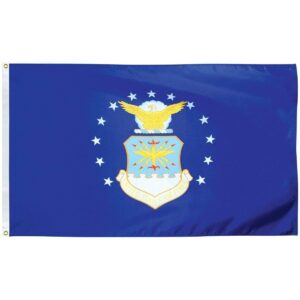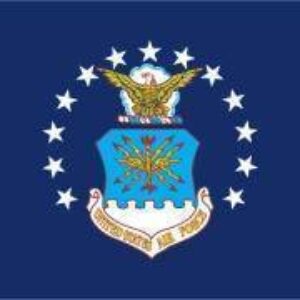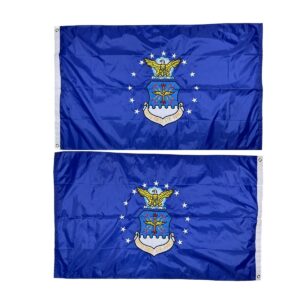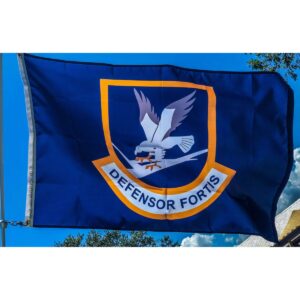Home » US Air Force Flags
Product Categories

US Air Force Flags
The Air Force Flag: A Symbol of Pride and History
 Welcome to an exploration of the United States Air Force Flag – a symbol of pride, history, and the unyielding spirit of the American military branch known as the Airforce.
Welcome to an exploration of the United States Air Force Flag – a symbol of pride, history, and the unyielding spirit of the American military branch known as the Airforce.
Table of Contents
- 1. Air Force Flag: Origin and History
- 2. Design and Symbolism of USAF Flag
- 3. Variations of the Airforce Flag
- 4. When to Use Air Force Flags
- 5. Interesting Facts about the Air Force Flag
1. Air Force Flag: Origin and History
The United States Air Force flag was officially adopted on March 26, 1951. This flag represents not just the Airforce but the legacy of air power in the USA. The origins of the flag are rooted deeply in the history of military aviation, reflecting the evolution of the Airforce as a distinct military branch.
2. Design and Symbolism of USAF Flag
The flag features the Air Force coat of arms, a bald eagle and a cloud formation, symbolizing the skies – the primary theater of Air Force operations. The flag’s design is a testament to the USA‘s aerial power. It is also adorned with sleeves and grommets, making it suitable for display on flag poles.
3. Variations of the Airforce Flag
There are several variations of the flag, including house flags and ceremonial banners. These are often seen flying high to support our troops and showcase the pride of the US Air Force.
4. When to Use Air Force Flags
The Air Force flag is used in various military ceremonies and events. It is a common sight at bases and in parades, symbolizing unity and respect for those who fly for the USA. The Air Force flag, is a powerful emblem of the American spirit.
5. Interesting Facts about the Air Force Flag
- Fact 1: The flag’s design was a result of a collaborative effort, reflecting the values and history of the US Air Force.
- Fact 2: The flag is often seen alongside other American flags, representing the unity of the military branches.
- Fact 3: Made in the USA, the flag’s quality ensures its durability in various weather conditions.
- FAQ 1: How often is the flag flown? Answer: It is flown during official ceremonies and at Air Force installations.
- FAQ 2: Can civilians fly the Air Force flag? Answer: Yes, it’s a way to support our troops and show patriotism.
The United States Air Force flag stands as a proud emblem of the American spirit, embodying the values and history of the Airforce and its role in the military branch of the USA. Its presence continues to inspire and support our troops, making it a revered symbol across the nation.
Table of Contents
- What is the mission of the United States Air Force?
- When was the Air Force established?
- What colors are in the Air Force flag?
- What does the Air Force flag symbolize?
- How is the Air Force flag displayed?
- What is the significance of the eagle on the Air Force flag?
- Can civilians use the Air Force flag?
- Where is the Air Force flag flown?
- What are the dimensions of the official Air Force flag?
- How does the Air Force flag differ from other military branch flags?
- Who designed the Air Force flag?
- What is the protocol for flying the Air Force flag with other flags?
- What do the stripes on the Air Force flag represent?
- How is the Air Force flag used in ceremonies?
- What is the history behind the Air Force flag’s creation?
- Are there any restrictions on manufacturing the Air Force flag?
- How often is the Air Force flag updated or changed?
- What materials are used to make the Air Force flag?
- Can the Air Force flag be flown at half-staff?
- What is the significance of the flag’s fringe?
- How is the Air Force flag incorporated into military uniforms?
- What is the significance of the flag’s position in formations?
- Are there any special ceremonies for the Air Force flag?
- How is the Air Force flag used in international contexts?
- What does the Air Force flag represent to Air Force personnel?
What is the mission of the United States Air Force?
The mission of the United States Air Force is to fly, fight, and win in air, space, and cyberspace, providing rapid, global mobility and precision engagement to defend the nation and its interests.
When was the Air Force established?
The United States Air Force was established on September 18, 1947, as a separate branch of the U.S. Armed Forces.
What colors are in the Air Force flag?
The Air Force flag primarily features ultramarine blue and gold, symbolizing the sky and the excellence required of Air Force personnel, respectively.
What does the Air Force flag symbolize?
The Air Force flag symbolizes honor, valor, and the heritage of the Air Force, reflecting its role in defending national security.
How is the Air Force flag displayed?
The Air Force flag is usually displayed with the flag of the United States, following protocol that ensures respect and dignity to the national flag.
What is the significance of the eagle on the Air Force flag?
The eagle on the Air Force flag represents the United States and the Air Force’s role in defending the nation’s skies.
Can civilians use the Air Force flag?
Civilians are allowed to display the Air Force flag as a sign of support and respect for the Air Force and its service members.
Where is the Air Force flag flown?
The Air Force flag is flown at military installations, during official ceremonies, and at public events where the Air Force is represented.
What are the dimensions of the official Air Force flag?
The official dimensions of the Air Force flag are typically 3 feet by 4 feet, but may vary depending on the specific use and location.
How does the Air Force flag differ from other military branch flags?
The Air Force flag is distinct in its symbols and colors, representing the unique duties and history of the Air Force as compared to other military branches.
Who designed the Air Force flag?
The Air Force flag was designed by an unknown artist and was officially adopted in 1951, symbolizing the Air Force’s independence as a separate branch.
What is the protocol for flying the Air Force flag with other flags?
When flown with other military branch flags, the Air Force flag is arranged according to the established order of precedence, usually determined by the date of each branch’s establishment.
What do the stripes on the Air Force flag represent?
The stripes on the Air Force flag do not have a specific symbolic meaning, but the design complements the overall appearance and significance of the flag.
How is the Air Force flag used in ceremonies?
In ceremonies, the Air Force flag is often carried alongside the national flag and is used in various military traditions and protocols.
What is the history behind the Air Force flag’s creation?
The Air Force flag was created to represent the Air Force as a separate branch following its establishment in 1947, reflecting its unique role and identity.
Are there any restrictions on manufacturing the Air Force flag?
Manufacturers of the Air Force flag must adhere to official specifications and guidelines to ensure accuracy and respect for the flag’s symbolism.
How often is the Air Force flag updated or changed?
The design of the Air Force flag has remained consistent since its adoption in 1951, with no frequent updates or changes.
What materials are used to make the Air Force flag?
The Air Force flag is commonly made from durable materials like nylon or polyester to ensure longevity and resilience in various weather conditions.
Can the Air Force flag be flown at half-staff?
Yes, the Air Force flag can be flown at half-staff during periods of national mourning or to honor fallen Air Force personnel, following the same protocols as the national flag.
What is the significance of the flag’s fringe?
The gold fringe on the Air Force flag is a decorative element that enhances its ceremonial appearance and is not a part of the flag’s official design.
How is the Air Force flag incorporated into military uniforms?
The Air Force flag is not directly incorporated into uniforms, but its elements and colors influence uniform patches and insignia.
What is the significance of the flag’s position in formations?
In formations, the Air Force flag’s position is symbolic of the branch’s role and status within the military hierarchy and is usually positioned according to protocol.
Are there any special ceremonies for the Air Force flag?
Special ceremonies involving the Air Force flag include change of command, retirement, and award ceremonies, where the flag is displayed with honor and respect.
How is the Air Force flag used in international contexts?
In international contexts, the Air Force flag represents the United States Air Force during multinational military exercises, meetings, and events.
What does the Air Force flag represent to Air Force personnel?
To Air Force personnel, the flag is a symbol of pride, commitment, and the history of their service, embodying the values and mission of the Air Force.

US Air Force USAF Flag 12 x 18 inch, 2×3 feet, or 3 X 5 ft. Standard


Air Force Flag Nylon Embroidered Double Sided Flags 12×18 inch, 2×3, or 3 x 5 ft.

U.S. Air Force Wings (Blue) Flag 12×18 inch or 3 X 5 ft. Standard


Air Force Police Flag – Outdoor Nylon – Made in USA – 12×18, 2×3, 3×5, 4×6, 5×8, 6×10, 8×12, 10×15 feet









